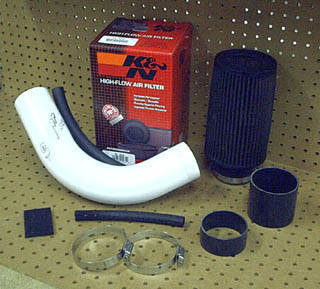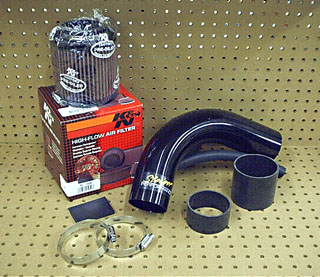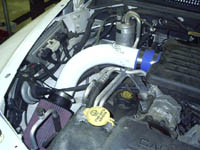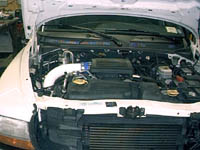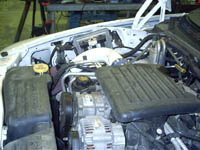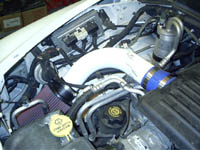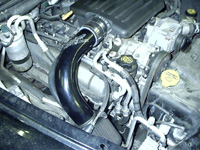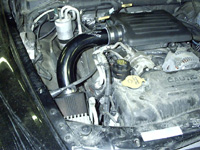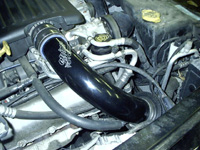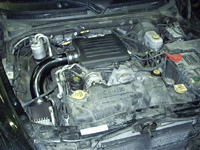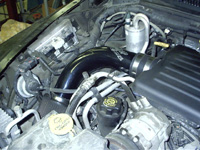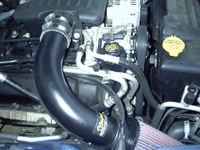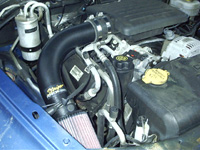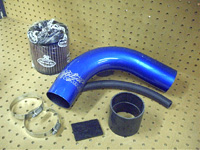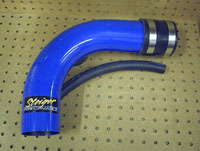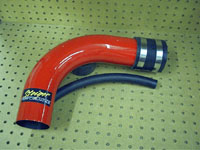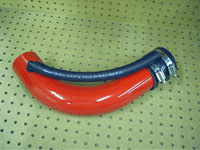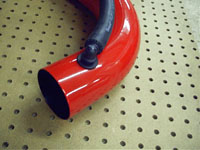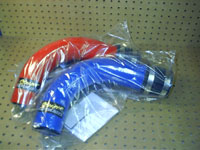This may not seem like a formula for better gas mileage, but the additional horsepower means the engine doesn't have to work as hard to do the same work, which will result in better gas mileage. This may seem like a strange concept, but it is true - a more powerful engine is often more fuel efficient than a less powerful one simply because it doesn't have to work as hard to do the same work. It is for this reason that the 3.9L V6 Dakotas and Rams quite often get about the same gas mileage as a 5.2L or 5.9L equipped vehicle. The smaller motor must rev longer and higher to accomplish the same task. This becomes especially evident while towing. A good example based on personal experience is a comparison between my 5.2L V8 Dakota and my family's 3.8L V6 minivan. For everyday driving, they both get around 17-18mpg. While towing a 6,000lb car trailer back from Carlisle, I averaged 13mpg in the V8 Dakota. We went on a family vacation in the minivan towing a 2,000lb motorcycle trailer, and got 11mpg. The V6 got 2mpg less than the V8 while towing, and that was with 1/3 the load! Proof positive that more power can indeed translate into better gas mileage.
This assumes of course, that you can keep your foot out of it.
Based on the trucks which have already had these intakes installed, we have noticed an average fuel economy increase of about 1 MPG in normal driving conditions, with an increase of around 1.5-2 MPG on the highway.
Truth be told, I wasn't actually planning on selling an air intake. As you may be able to tell from the other products that I offer, I like to create unique things that nobody else has or that you don't find in every parts store and performance catalog. It seems like everybody and their brother is offering Dakota air intakes these days! Such wasn't the case when I first started working on this project however. A buddy of mine bought a brand new QC Dakota with the 4.7 in 2000, and it (the 4.7 in the Dak/Durango body) was so new that there was nothing yet available. I offered to create a one-off intake for him, and at some point during the design process, I thought maybe I should offer them via Steiger Performance so anybody else who wanted one could have one as well. The intake wasn't a real priority, and work commenced on and off for a year or so. Of course, by that time there were a few other alternatives. I decided to go ahead and offer my version for sale though partially because of all the time and expense I had invested in it to that point and partially because my intake is different in some respects than others on the market, so I thought perhaps it would appeal to some of you.
Ok, on to the intake. My intake consists of a mandrel bent 16 gauge steel tube which I plumb for the PCV hose and powdercoat inside and out. A silicone connector attaches it to the intake plenum using a pair of high torque stainless steel hose clamps. The filter is a K&N, which has been pre-oiled at the factory and comes with their 1 million mile warranty. This is all excellent quality stuff. I personally hand-build each intake myself. This isn't something I'm buying from someone else or farming out. As such, I can offer a level of customization not available on a mass produced unit. The most obvious of which being that I can powdercoat it many different colors. Now, I'm not saying that it'll exactly match your truck's paint, but there is probably a powder available which is close. Or, if you prefer, it can be done in a contrasting color. There are also other things that can be done like wild custom colors such as metallics, flourescents, translucents, iridescents, textures, prism effects, etc. I have a set of "standard" colors which I keep in stock and which are included in the price of the intake. However, there are many other colors and options available for an additional fee. To get an idea of what is available, check out hotcoat.com, (a popular powdercoating site) and click on "Powders" or "Colors". Click here for more powdercoat info and pricing details.
I do not yet have any solid performance data on my intakes. (i.e. no dyno runs or before/after 1/4mi times) However, the owners of the trucks on which they have been installed are very happy with them, and have noticed a "seat of the pants" increase in power, better throttle response, etc. Don't get me wrong - an intake isn't a shot of nitrous; its not a huge difference, but you will notice a difference. An air intake is only one part of the whole package. You can't expect to bolt one onto a stock truck and go play with the Vipers!
My main goal with these intakes was to create a simple, quality intake with a reasonable price tag. That's definitely not an easy task as quality and low price do not usually go hand in hand, and I can't take advantage of economies of scale due to the low volumes involved. As a fellow hot rodder, I'm always looking for the best value for my money, and that's the mindset I use when creating my products. To be completely honest with you, the prices came out a bit higher than where I was hoping, but there's nothing I can do about that without compromising on quality; a path I am not willing to take. However, I have decided to offer these intakes in several different ways which, depending on your circumstances, might save you some money:
- 4.7L intake kit
- This is the normal intake kit, as described elsewhere on this page - it comes with illustrated install instructions, the K&N filter, the tube is powdercoated and plumbed for the PCV valve, etc. Basically, you pull it out of the box and bolt it on.
- 4.7L intake kit, minus filter
- This is exactly the same as above, but the K&N filter is not included. I offer this option in case you have a cheap source of K&N filters, or have a Summit gift certificate, etc. You may be able to save a few bucks.
- 4.7L intake kit, minus powdercoat
- This is the full intake kit, except that the tube is sent to
you "raw"; it will be bare metal and you will be responsible
for applying a finish to it. Perhaps you want to spray paint it with
one of those fancy color shifting paints, or maybe you would like to
have it chromed, or gold plated, who knows?
 At any rate, this will save you
the powdercoating charges. Note that because the tube will be bare
metal, you should apply some sort of finish to it before using it,
otherwise it will be susceptible to rust and corrosion. When the
intake is shipped to you, the tube will be protected with a light oil
and sealed in a plastic bag to prevent rust, but once you open it up
and clean it off, be aware that you should apply a finish fairly soon.
At any rate, this will save you
the powdercoating charges. Note that because the tube will be bare
metal, you should apply some sort of finish to it before using it,
otherwise it will be susceptible to rust and corrosion. When the
intake is shipped to you, the tube will be protected with a light oil
and sealed in a plastic bag to prevent rust, but once you open it up
and clean it off, be aware that you should apply a finish fairly soon.
- 4.7L intake kit, minus filter, minus powdercoat
- Fairly self explanatory
 This is the
intake kit, but without the filter and without the powdercoat.
This is the
intake kit, but without the filter and without the powdercoat.
| Filter | RE-0910 (5 speed) | RU-2430 (auto) |
|---|---|---|
| Base Diameter | 5" | 5" |
| Top Diameter | 4 5/8" | 5" |
| Length | 8" | 5" |
| Effective filtering area | 109.6 sq. in. | 66.8 sq. in. |
| Theoretical max displacement | 486ci (8.0L) | 296ci (4.9L) |
The 4.7L has a horsepower peak of around 4700 RPM, and therefore requires approximately 64.7 sq. in. of filtering area. The "theoretical max displacement" figures in the table above refer to the size engine these filters would be able to support, given the same ~4700 RPM HP peak, according to K&N's formulas. As you can see, the 5 speed filter is more than adequate, and although the auto filter is close, it is indeed in excess of the requirements of the 4.7L. Also, keep in mind that the numbers I am working with are theoretical, and are actually quite conservative. In the April 2002 issue of Car Craft magazine, an interesting dyno test was done by Marlan Davis and Westech using a 448ci (7.3 L) Chrysler motor, with various sized air filters. The horsepower peak on this particular motor was approximately 520hp at 5200 RPM. The purpose of the test was to determine what the actual effect of different sized air filters has on power output. The largest filter tested was 14x6" (230.9 sq. in. effective filtering area), which would in theory, be enough to support an engine of about 925ci (15.2 L). The smallest filter tested (just for laughs) was 7x3" (49.5 sq. in. effective filtering area), which would in theory, only be enough to support an engine of about 198.3ci (3.3 L). However, the tiny filter came in at 0.6 HP and 6.1 lb-ft more than the monster filter - in fact all the filters which were tested came in within 4 HP of each other, a range which was smaller than the dyno's margin of error. The conclusion that the testers came to was that for all practical purposes, all the filters made the same power. Some may be of the opinion that the auto filter included in my kit is too small, but it does indeed come in at larger than the theoretical required size, and when you consider this dyno evidence, these theoretical sizes are obviously extremely generous! It is for these reasons that I am confident that this filter is more than adequate for the truck. If I felt otherwise, I wouldn't sell it!
In my opinion, the only real difference you will see between these two filters has to do with the cleaning interval. As the filters accumulate dirt, they will actually filter better, but the restriction does go up. With the larger 5 speed filter, you will be able to go longer before noticing a decrease in performance due to filter clog. However, the K&N filters can be cleaned and "recharged"; you don't have to replace them like conventional paper filters. (K&N sells a "recharge" kit which you can pick up just about anywhere for about $10 which allows you to clean and re-oil your filter several times.) Although K&N does say that the filter should be replaced after having been cleaned about 25 times, by the time you get to that point, your truck will be a classic!
By the way, just for reference, power fluctuates approximately 1% for every 10 degrees of temperature difference. A decrease of two degrees would result in approximately two tenths of one percent more power. On a 235hp engine, that equates to less than one half horsepower. If you are truly concerned about such a small difference, you shouldn't be considering an air intake anyway. You should be looking at an aftermarket cowl induction or ram-air hood that dumps outside air directly into the throttle body. Any "cold air induction" system that draws cold air from anywhere else and conveys it to the throttle body via a tube is a compromise.
For details about what exactly is involved to install this intake, check out the full color install instructions in Adobe PDF format.
This intake is compatible with both A/C and non-A/C equipped vehicles, as well as both cruise control and non-cruise control equipped vehicles.
NOTE: THIS PRODUCT HAS BEEN DISCONTINUED UNTIL FURTHER NOTICE
| Home | © 1999-2025 by Steiger Performance. All rights reserved. |
